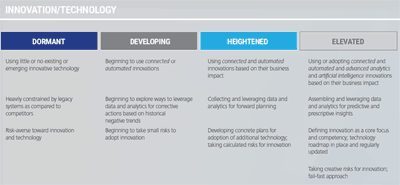MHI's Report on Supply Chain Digitization Part 2
Last week, I started my review of the annual report released a few months ago by MHI and partner Deloitte, focused on digitization.
I spent some time chronicling the efforts of MHI - once the Material Handling Industry of America, a trade association for material handling related suppliers of all kinds, with membership at the company not individual level - to move more upstream.
By that I mean to position the organization as more of a supply chain focused entity, making it perhaps more relevant to business and even society than to be more restricted to just the materials handling domain.
| GILMORE SAYS: |
With AI designed to "to mimic or extend human functions, enabling it to reason and intelligently interact with the environment," this is I guess where the software robots just take over.
WHAT DO YOU SAY?
Send us your
Feedback here
|
I would say that transformational effort has only partially been successful. One element of the strategy, as I noted last week, was to work with Deloitte starting maybe 5-6 years back on a new annual report that was much more supply chain and thought leadership oriented versus the previous style annual reports that focused on industry statistics for the famously cyclical materials handling sector.
The theme of this year's report is supply chain digitization - a worthy but challenging topic. Worthy because digitization is near the top of the CEO agenda, as survey after survey shows. Challenging because it's hard to know digitization in the supply chain really means beyond being a collection of disparate technologies, from drones to artificial intelligence, rather than something we might view as more holistic in its parameters.
Last week, I mostly summarized the results of survey data supporting the report, largely around what supply chain pros think across various dimensions for about 11 digital technologies.
This week, I offer a summary of the report's more interesting general discussion of digitization.
The report argues that a variety of pressures, largely around ecommerce and what it calls the "always on" supply chain, demand digitization to achieve required new levels of performance.
A discussion of what some see as a supply chain talent gap - not enough skilled managers to go around - included this interesting thought: organizations in the early stages of digital maturity face a chicken-and-egg problem, in which they have a tremendous need for digital talent, yet their lateness to embrace a digital culture makes them less attractive to such talent.
The report hopes to help companies on their journeys by offering a four-stage framework for digital maturities. Those four stages are:
Stage 1 - Digital Connectivity: Stage 1 involves the process of collecting, cleansing, and organizing data from multiple sources inside and outside a given enterprise to achieve real- time, end-to-end supply chain visibility.
"This stage can provide a strong foundation for the digital supply chain, priming the pump by taking the digital information that is now so readily available and converting it into a more usable form," the report says.
Among the overall laundry list of digital technologies mentioned above, key to reaching stage 1 are these: Cloud computing; sensors and automatic identification; the industrial Internet of Things; and Blockchain and distributed ledger technologies.
Cited as an example of all this is an unnamed food company that the report says has tested a combination of sensors with Cloud analytics to reduce retail food waste. The sensors continuously monitored and reported the products' location and the elapsed time since it left the field, while also measuring the temperature and humidity that the product was exposed to on its journey through the supply chain. Using the temperature, humidity, and elapsed time information, a Cloud-based analytics solution could apply multiple algorithms to predict product freshness.
It does not appear, however, the system has gone beyond the test. I wonder why.
Stage 2 - Automation: In stage 2, automated systems, robotics, and augmented technologies are deployed to perform repetitive, resource-intensive supply chain tasks, with a goal of streamlining operations and making them safer, quicker, and more reliable.
Key technologies in reaching this stage include: robotics and automation, autonomous vehicles and drones; wearable and mobile technology; and 3D printing.
Stage 3 - Advanced Analytics: This stage is all about converting mountains of data into valuable nuggets of insight, the report says.
Key digital technologies in this phase include: Inventory and network optimization tools; predictive analytics; and prescriptive analytics.
The latter two technologies, as most know, come from a popular analytic framework that first involves being able to predict what will happen in the supply chain, and then with prescriptive analytics having the computer tell us what to do about it.
The case study presented with this stage involves an airline that hoped to reduce its global parts inventory, using in large part an "analytics control tower" that combined multiple disparate data sources and incorporated predictive analytics used by senior executives down to maintenance managers.
Stage 4 - Artificial Intelligence: Stage 4, as the name makes clear, involves using AI to take the digital information from other stages and generate smarter insights, while at the same time getting smarter itself by learning from patterns, behaviors, and feedback from various digital and human interfaces.
With AI designed to "to mimic or extend human functions, enabling it to reason and intelligently interact with the environment," this is I guess where the software robots just take over.
So the report's four stage model is fine, and I do like connecting the 11 digital technologies to each stage. But does all this digitization investment and effort all roll up in the end to AI? That I am not so sure. Also not discussed at all are the workforce and societal impacts of the coming AI revolution.
As briefly mentioned last week, the report promotes the concept of "Elevating Supply Chain Digital Consciousness."
What exactly is that, you ask? It's really a sort of self-assessment tool that allows a company to assess its digital mindset and gauge its progress on the journey to becoming more digital.
The Supply Chain Digital Consciousness framework characterizes a supply chain on four levels of awareness (dormant, developing, heightened and elevated), across five digital categories (leadership, innovation/technology, customer engagement, talent and workplace environment).
The assessment tool for the category of technology/innovation is shown in the graphic below from the report:
|



![]()

![]()

![]()

![]()











